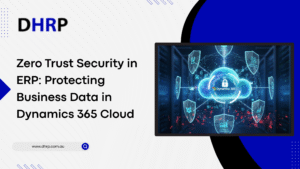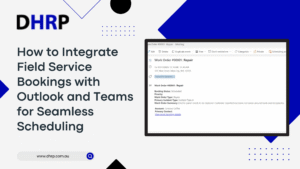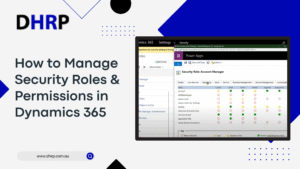The old phrase, “trust but verify,” has now expired quietly. Data privacy is everything in this world, where everything depends on it. Especially when we talk about the businesses using ERP, you are running on data. A minor breach can cause bigger troubles. Therefore, to fill the security gap, zero trust in ERP is only increasing.
In fact, when we look at the data, the demand for such security is only increasing. According to the report, the Zero Trust Enterprise Security Market is projected to grow at a compound annual growth rate (CAGR) of 14.5% from 2026 to 2033, from an estimated USD 30.5 billion in 2024 to USD 100 billion by 2033.
As your business steps into the future, it is essential to understand how zero trust security in ERP solutions, such as Dynamics 365 cloud, can protect sensitive data. Implementing blockchain in ERP can further enhance data integrity, complementing Zero Trust measures.
By the end of this blog, you’ll understand how to implement zero trust security in ERP and safeguard your Dynamics 365 business data effectively.
Why ERP Security Demands a Zero Trust Mindset
Old-school examples of security, such as firewalls, VPNs, and network segmentation, were designed for static environments. As for the cloud-based ERPs like Dynamics 365, the dynamics in the name tell the whole story.
This system is a borderless ecosystem and manages multiple departments. Users connect from anywhere around the world using various devices and through third-party apps.
Implementing hyperautomation in ERP further streamlines processes, but it also makes adopting a zero trust mindset essential to secure automated workflows and sensitive data across the organisation.
Here are the key risks your ERP faces today:
- The Insider Paradox:
Employees and contractors often have more access to data than necessary. This is where privilege creep becomes a silent vulnerability.
- Third-party Blind Spots:
ERP integrations with additional departments, such as logistics, finance, and analytics platforms, expand the attack surface.
- Hybrid Work Risks:
Recently, more companies are implementing hybrid work, which puts your system at risk due to the overuse of personal devices.
- Cloud Misconfigurations:
A single overlooked permission in Azure can also put your ERP at risk, exposing the sensitive ERP datasets.
The Zero Trust Framework - From Theory to ERP Reality
The zero-trust model relies on three simple principles: verify explicitly, use least privilege access, and assume breach. When implemented with Dynamics 365 cloud security, these principles fit perfectly with Microsoft’s cloud-native security architecture.
- Identity-Centric Access Control
- Micro-Segmentation and Contextual Security
- Continuous Monitoring and Adaptive Defence
Building Zero Trust into Dynamics 365: Practical Layers of Defence
Now, even if you think that AI in Dynamics 365 ERP automation can save you, you still need full protection. So, here are ERP security best practices 2025:
1. Identity and Access Hygiene
The foundation is still strong in identity governance. In Azure AD:
- Make MFA the default setting for all ERP access points.
- Use Just-In-Time (JIT) access for administrators, temporary privileges that expire automatically.
- Implement Conditional Access rules according to risk score, IP reputation, or device compliance.
By doing away with static credentials, this model guarantees that all ERP interactions are encrypted, authorised, and authenticated.
2. Data Protection and Sovereignty
Data sovereignty is more than just a catchphrase in Australia; it is required by the Privacy Act 1988 and the Australian Privacy Principles (APPs) to be followed. While Customer-Managed Keys (CMKs) give you control over encryption lifecycles, Dynamics 365 ERP security makes encryption possible both in transit and at rest.
To protect sensitive ERP data from internal misuse or unintentional leaks, combine this with information rights management (IRM) and data loss prevention (DLP) policies.
3. Network and Endpoint Assurance
ERP security should extend beyond granting users access to the devices they use. Before allowing access, companies can verify endpoint posture with Microsoft Intune by looking at OS versions, patch status, and security baselines.
This guarantees that hardened, policy-compliant endpoints are being used to connect, even for remote users logging in from Sydney, Perth, or Darwin.
4. Threat Visibility and Automation
Zero Trust really depends on telemetry. By integrating Microsoft Sentinel, you can consolidate security events from Dynamics 365, Azure, and Microsoft 365 into a unified analytic stream.
Additionally, automation rules can quickly take action, such as disabling hacked accounts or isolating infected devices, all without requiring manual intervention.
The Strategic Advantage: Protecting Business Data in Dynamics 365
Zero Trust might appear to be just one of the other cybersecurity ERP data protection strategies at first glance, but it actually encompasses governance, risk management, and the agility of a company. For businesses in Australia, using Zero Trust with Dynamics 365 brings a bunch of advantages:
- Data Integrity and Business Continuity: Sure, breaches can still happen, but the damage they cause is way less.
- Regulatory Confidence: It’s easier to stick to standards like ISO 27001, APRA CPS 234, and the Australian Privacy Principles because you have better visibility and access control in place.
- Scalable Security: As your ERP needs grow globally, Zero Trust adapts smoothly without needing a complete overhaul of your security perimeter.
- Cultural Transformation: This approach changes the game, making security a collective effort rather than just an IT job. It gets woven into everyday workflows instead of being something added on later.
The Real Challenge: Trust as a Human Problem
Technology sets the rules, but Zero Trust also requires a shift in company culture. Employees who are accustomed to convenience may view multi-factor authentication and access limitations as annoying hurdles. On the other hand, executives may not fully understand the potential dangers of insider threats or third-party risks.
Communication is key here. We need to present Zero Trust not just as a limitation but as a way to boost trust, allowing safe teamwork, remote operations, and innovation while keeping data secure.
When done right, Zero Trust transforms ERP security from just a box to check for compliance into something that can actually set a business apart. Companies that can show their data is trustworthy are likely to gain an edge in customer trust and digital partnerships.
Conclusion
Implementing Zero Trust security in ERP is no longer optional—it’s essential for protecting sensitive business data in cloud environments like Dynamics 365.
By adopting a zero trust mindset, organisations can enforce identity-centric access, continuous monitoring, and strict data protection policies.
Partnering with experienced ERP consultants and leveraging Dynamics 365 implementation services ensures that security frameworks are configured correctly and efficiently.
With DHRP’s professional support, businesses can safeguard their ERP systems, maintain regulatory compliance, and enhance operational resilience. Zero Trust not only prevents breaches but also fosters a culture of secure collaboration, providing companies with a strategic advantage in the digital era.
FAQs
Zero Trust Security in ERP assumes no implicit trust, verifying every user, device, and transaction to ensure security. It limits access, continuously monitors activity, and reduces insider and external threats to protect business data.
Dynamics 365 Cloud protects data using identity-based access control and encryption at rest and in transit. It also applies conditional access, multi-factor authentication, and continuous monitoring to safeguard sensitive ERP information.
Best practices include enforcing least-privilege access and applying multi-factor authentication. Additionally, leverage conditional access policies, monitor endpoints, encrypt sensitive data, and continuously audit workflows with the help of ERP consultants for robust protection.



































































































